Back to Report Introduction
Massachusetts Work-Based Learning Plan
Skill Gain Study
Summer 2007
Do participants gain skills?
Section 3 of the Work-Based Learning Plan provides data that can be used to analyze skill gain. For each skill, ratings are provided on a five-point scale, as shown below. For this report, the set of plans that had first and second reviews was selected, and the average rating at first review, average rating at second review, and average change were calculated for each skill, for all skills overall, and for specific subsets of Work-Based Learning Plans.
| |
(1) |
(2) |
(3) |
(4) |
(5) |
| |
Performance Improvement Plan Needed |
Needs Development |
Competent |
Proficient |
Advanced |
| [Skill] |
| First Review |
[ ] |
[ ] |
[ ] |
[ ] |
[ ] |
| Second Review |
[ ] |
[ ] |
[ ] |
[ ] |
[ ] |
Participants showed skill gain during their work-based learning experiences, as measured by ratings on the WBLP. Average ratings for all of the “Foundation Skills” and the “Workplace and Career Specific Skills” were higher at the second review than at the first, initial review.
Table 1: Foundation Skills
From a sample of 354 WBLPs |
| Foundation Skills | 1st Review | 2nd Review | Average Change |
| Attendance and Punctuality | 3.40 | 3.77 | .36 |
| Workplace Appearance | 3.50 | 3.85 | .35 |
| Accepting Direction and Constructive Criticism | 3.30 | 3.79 | .49 |
| Motivation and Taking Initiative | 3.24 | 3.72 | .48 |
| Understanding Workplace Culture, Policy and Safety | 3.32 | 3.77 | .46 |
| Speaking | 3.23 | 3.73 | .50 |
| Listening | 3.37 | 3.82 | .45 |
| Interacting with Co-Workers | 3.40 | 3.86 | .46 |
| Foundation Skills TOTAL | 3.34 | 3.79 | .45 |
Foundation Skills
 = Review #1 = Review #1
 = Review #2 = Review #2
|
|
Attendance and Punctuality
|


|
|
Workplace Appearance
|


|
|
Accepting Direction and Constructive Criticism
|


|
|
Motivation and Taking Initiative
|


|
|
Understanding Workplace Culture, Policy and Safety
|


|
|
Speaking
|


|
|
Listening
|


|
|
Interacting with Co-Workers
|


|
|
Foundation Skills Total
|


|
Table 2: Workplace and Career Specific Skills
From a Sample of 433 Work-Based Learing Plans |
| Specific Workplace and Career Skills (SELECTED, MOST COMMON SKILLS) | 1st Review | 2nd Review | Average Change | Number of Plans |
| Collecting and Organizing Information | 3.45 | 4.03 | .58 | 174 |
| Time Management | 3.20 | 3.75 | .55 | 126 |
| Equipment Operation | 2.99 | 3.67 | .68 | 120 |
| Computer Technology | 3.70 | 4.20 | .50 | 100 |
| Interacting with Customers or Clients | 3.47 | 4.05 | .58 | 94 |
| Reading | 2.95 | 3.48 | .53 | 80 |
| Project Management | 3.46 | 3.94 | .48 | 63 |
| Writing | 2.95 | 3.58 | .63 | 59 |
| Teaching and Instructing | 3.56 | 4.16 | .60 | 48 |
| Math and Numeric Analysis | 3.32 | 3.95 | .63 | 41 |
| ALL WORKPLACE AND CAREER SPECIFIC SKILLS (Including others not shown here) | 3.29 | 3.88 | .60 | 433 |
Workplace and Career Specific Skills
 = Review #1 = Review #1
 = Review #2 = Review #2
|
|
Collecting and Organizing Information (N=174)
|


|
|
Time Management (N=126)
|


|
|
Equipment Operation (N=120)
|


|
|
Computer Technology (N=100)
|


|
|
Interacting with Customers or Clients (N=94)
|


|
|
Reading (N=80)
|


|
|
Project Management (N=63)
|


|
|
Writing (N=59)
|


|
|
Teaching and Instructing (N=48)
|


|
|
Math and Numeric Analysis (N=41)
|


|
|
ALL WORKPLACE AND CAREER SPECIFIC SKILLS (Including others not shown here)
|


|
FOOTNOTE: A related question is: Is the WBLP a valid measure of skill gain? It is interesting to note that the amount of skill gain varied by the type of work experience and by the effort put into the WBLP by the supervisor or career specialist, as measured by the amount that was written in the various sections of the plan. This variation suggests that the skill gain is “real” and not simply the result of a natural tendency to provide a higher rating at a second review. [In statistics, a similar concept is seen in medical research in the concept of a “dosage effect.” If a treatment is more effective at higher dosages, within a reasonable range, then it can be concluded that the treatment is effective, and that the results are not simply the result of a placebo effect.]
Read More









































